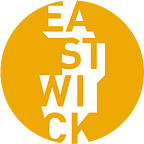5 Questions with Christina Farr, Health Tech Reporter at Fast Company
During our sit-down with Christina last month, I was struck by small nuances of her style — perhaps being the “questioned” rather than the “questioner” contributed. First, we would pose questions about her writing, beat, or relationships and there would be a meaningful pause before she responded, usually coupled with lingering eye contact with the person who asked the question. Second, at times I felt she was coaching us on interviewing — guiding us towards the next questions, leaving breadcrumbs for follow-ups or signals that we should do more digging. Observing both behaviors, whether they’re techniques or simply part of Chrissy’s innate style, increased our empathy for clients on the other side of her questions and helped shape our outreach to reporters in the future to better anticipate how a conversation may go.
We also chatted about Fast Company, her (un)official bullshit committee, and buzzwords.
Where do you get ideas for stories?
Chrissy has covered the health tech beat for the past three years; she has carried a group of loyal readers with her across three publications and has amassed a collection of confidants, sources, and friends in the industry. She sources ideas from her social community: “every morning I wake up to a comment or Tweet from someone with a story.”
She uses Twitter polls and the data often ends up in her stories — she can get up to 1,000+ responses.
What should agencies know about pitching ideas?
Chrissy gave Eastwick the download on the new Fast Company News Stream, a stream of stories written with an informal, first-person narrative, usually about three paragraphs long and banking on the reporter’s in-depth knowledge of the subject matter to add value to hard news. Chrissy said she usually spends about an hour of her day working on News Stream covering five pieces of news, and feels encouraged to “have a little fun with it.” She will share interesting quotes from interviews that may not make it into another longer piece, or an interesting Tweet. Every reporter at Fast Company is currently contributing to News Stream in this way.
PR agencies should know that usually embargoed news is destined for News Stream. Fast Company’s readers are more interested in in-depth pieces, so they don’t invest a lot of time in pieces that will be published in 12 other places. For Chrissy, this is exciting because she now has more hours in the day for big, meatier, “why” stories. But, she has seen frustration when announcements land in News Stream, falling short of a company’s expectation of feature piece. The best PR people read the News Stream hits and take the opportunity to build a relationship with her for later. “If I was skeptical on their news, perhaps that is cause for an introduction to the CEO,” she said.
Chrissy also likes to use News Stream for breadcrumbs reporting. She shares updates in the form of quotes, data, or anecdotes from her long-tail reporting publicly. This is a great way for her readers to stay engaged in stories she is working on as they develop, and News Stream is a fun venue to explore new formats for sharing the information.
What is your process like once you receive a pitch?
Over the years, Chrissy has fostered relationships with doctors as well as leaders within healthcare companies, technology companies, venture capital firms, and accelerators. She told Eastwick (cautiously) that she has an informal “bullshit committee” that she will often engage to get their off the record take on startups or announcements. “This group is my go-to resource more than talking to founders at-length… I know what [the founders] are going to tell me,” she told us when we asked about how she balances her input from her committee with when to take a meeting with an early-stage company.
What not to do in an interview?
“If you use tons of buzzwords or jargon in an interview it makes me think you don’t know what you’re talking about,” she said. She can definitely hear when people are using marketing materials as a script and it comes off disingenuous.
What is frustrating for you about the health tech beat right now?
As a health tech reporter, Chrissy has the ability to get first-hand experience with the way digital technologies are changing the industry by going to her doctor. However, therein lies the problem. “It feels disingenuous [in healthcare writing] to write about how new companies are innovative and transformative, then go to her doctor the next day only to see that nothing has changed,” she told us. She wants to write about practical stories, with step-by-step progress towards change. If she can’t show progress, it can feel like she is writing misleading stories.
Want more?
Follow Chrissy at @chrissyfarr
Read her stories on Fast Company
Read more of Eastwick’s interviews with reporters
